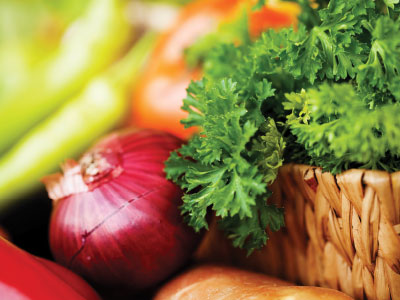Meet our nutrition team
This article was originally published in January 2015

Our nutrition education team, comprised of Nick Rose, M.S., and Marilyn Walls, M.S., regularly provides PCC shoppers with expert advice on special diets, how to read food labels, recipes and more.
They lead our popular Walk, Talk and Taste classes, a free 90-minute tour that leads you through our aisles to expand your knowledge of food, nutrition and what makes PCC products so unique. They respond to your nutrition questions via nutrition@pccmarkets.com, and you’ll find them in the community, discussing good nutrition to schools, workplaces and parenting groups.
We asked both Nick and Marilyn for a single piece of nutrition advice for 2015. Here’s what they had to say: “Eat more fresh fruits, vegetables and herbs.”
Boost your basket

by Nick Rose, M.S., PCC Nutrition Educator
Making fresh produce the foundation of your diet is the single most important nutrition guideline to follow, but most of us have a pretty hard time making “half your plate fruits and vegetables” as recommended by doctors and dietitians. New research is finding that people who eat the most vegetables and fruits (usually 7 to 9 servings/day) each day are more optimistic, happy, satisfied with their lives, and creative. So we can now add mental health to the long list of health benefits attributed to fresh produce.
Nationwide the average shopping basket contains just 10% produce. PCC shoppers are doing much better, filling their baskets with closer to 20% produce. But we can all do a little better — whether your typical shopping basket is 10%, 20%, or 30% produce, there is always room for improvement.
When you are at the market, evaluate the percent of your shopping cart (or basket) that is vegetables and fruits, and consider adding more fresh produce to boost your basket. Here are a few tips:
- Look for something seasonal. PCC’s produce department identifies local produce and often highlights the most seasonal items.
- Ask our produce staff to recommend popular produce options, or how they like to cook different vegetables or fruits.
- Research shows that having a bowl of fruit on your kitchen table will increase fruit consumption of everyone in the house … so fill it up!
- Kids ages 12 and under enjoy a free serving of a fruit or vegetable every time they visit PCC.
Nick Rose has a master’s degree in nutrition from Virginia Tech. He has taught nutrition classes at his alma mater as well as Bastyr University.
More than just a pretty garnish

by Marilyn Walls, M.S., PCC Nutrition Educator
While loading up your shopping cart with fruits and vegetables, don’t forget those fresh herbs. These humble plants add flavor, color and texture to your cooking along with all kinds of nutrients.
Parsley, for example, is more than just a decorative leaf with a mild flavor. It’s a powerhouse of vitamins, minerals and antioxidants. Half a cup of parsley provides vitamins A, C, and K while contributing folate for your brain and calcium for your bones. The flavonoids in parsley can activate your immune system. And did you know parsley can act as an after-dinner breath mint? The rich green color of parsley comes from chlorophyll, which absorbs odor. Other common herbs also have plenty to offer: cilantro supports detoxification, peppermint aids digestion, and fennel bulb gently stimulates liver function.
When selecting herbs, aim for fresh — they have better taste and more health benefits. In fact, fresh herbs have twice the vitamin content as dried herbs. Incorporating herbs into your cooking doesn’t have to be complicated either. Buy a bunch of parsley and sprinkle the leaves over salad, eggs or soup. Just be sure to add fresh herbs near the end of your cooking process to retain their nutrition and fantastic flavor.
Marilyn Walls has a master’s degree in nutrition from Bastyr University, where she also spent three years as an adjunct professor.
